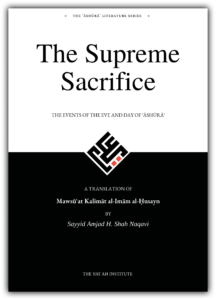
The Supreme Sacrifice
The Events of the Eve and Day of ʿĀshūrāʾ
A translation of Mawsūʿat Kalimāt al-Imām al-Ḥusayn, by Sayyid Amjad H. Shah Naqavi
One of the most important and influential events in Islamic and world history, commemorated annually on 10th Muḥarram by religious communities around the world and a central aspect of Shia Islam, ʿĀshūrāʾ marks the martyrdom of al-Ḥusayn b. ʿAlī, the grandson of the Prophet Muḥammad – may God bless him and his descendants – and the third Shia Imām. Killed during the massacre of Karbala after encountering an army sent by the second Umayyad caliph Yazīd b. Muʿāwiyah (r. 680–683), Imām al-Ḥusayn, peace be upon him, has been remembered and honoured since his martyrdom as a supreme exemplar of sacrifice for God and for faith, and he endures as a symbol of resistance against oppression, tyranny, and injustice to this day. In modern times, the annual pilgrimage to the Shrine of Imām al-Ḥusayn to mark forty days after ʿĀshūrāʾ, known as Arbaʿīn, is counted amongst the largest religious gatherings in the world. More than thirteen hundred years after Karbala, ʿĀshūrāʾ remains a momentous event in the Muslim calendar – as well as in many other cultures worldwide – and is commemorated through pilgrimages, prayers, and mourning rituals including processions, lamentations, elegies, and dirges.
In The Supreme Sacrifice, the Dean of The Shīʿah Institute, Dr Sayyid Amjad H. Shah Naqavi, presents an accurate and reliable translation of Mawsūʿat Kalimāt al-Imām al-Ḥusayn, a compendium of sources of Imām al-Ḥusayn’s words, writings, biography, and martyrdom. Through a critical examination of early manuscript sources, narrated traditions, and the historiography of events and actions leading up to and during the massacre of Karbala and its subsequent commemorations, The Supreme Sacrifice makes an authoritative account of ʿĀshūrāʾ available to an English-speaking readership. Drawing upon decades of research into early Islam, classical Arabic philology, and Shīʿī literary and commemorative traditions in the Middle East, South Asia, and beyond, Dr Sayyid Amjad H. Shah Naqavi’s translation will be of lasting value to scholars and students of religion, literature, and history, as well as general readers.
The Supreme Sacrifice is the eleventh volume in The Shīʿah Library series.
